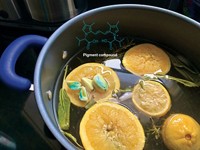[+]Enlarge

WHAT'S COOKING IN CHEMISTRY? How Leading Chemists Succeed in the Kitchen
WHAT'S COOKING IN CHEMISTRY? How Leading Chemists Succeed in the Kitchen, edited by Hubertus P. Bell et al., Wiley-VCH, 2003, 229 pages, $40 (ISBN 3-527-30723-0)
As a longtime cook and chemist--I began cooking when I was 10 and knew I wanted to be a chemist when I was 13--I couldn't help but be fascinated by a book titled "What's Cooking in Chemistry?" Clearly, this title could refer to a number of things, such as new advances in the profession I love, but the subtitle, "How Leading Chemists Succeed in the Kitchen," explained it all.
You can make a marinade for BBQ kangaroo, courtesy of Martin Banwell (Australian National University). Of course, you will need to be able to find kangaroo, which Banwell notes is "a very lean, popular, and readily available meat in Australia." The marinade can also be used with beef, but given the recent mad cow problem in the U.S., perhaps one should seriously search for kangaroo in a gourmet shop.
For further variety, Robert G. Bergman (UC Berkeley) offers up potato latkes. This dish, he reminds us, is one that Jewish people serve during Hanukkah. He also describes the origins of this holiday.
Yoshinori Yamamoto (Tohoku University) provides a recipe for tofu tempura and the advice that "together with this tofu tempura, drinking beer (or wine) is very enjoyable, and hopefully fruitful to arouse one's vitality for doing research and administrative work ... on the next day."
There are many Italian dishes, including tagliatelle alla Bolognese from Gianfranco Cainelli (University of Bologna), pasta al forno southern Italian style from Rocco Ungaro (Parma University), and cannoli shells from Dale L. Boger (Scripps Research Institute).
And there are other just plain good recipes. I particularly like the veal and sausage stew from Ronald Breslow (Columbia University), who helpfully instructs the reader to remove the bitter core of the garlic before chopping; Erick M. Carreira's (ETH Zurich) black bean soup--Carreira was born in Cuba and the recipe is a family one; and Robert H. Grubbs's (Caltech) pecan pie, his mother's recipe--Grubbs grew up in the South, having been born near Possum Trot, Ky.
Reading the recipe for Lawrence T. Scott's (Boston College) fruitcake may make it difficult to take it seriously, but it is a real recipe and certainly amusing to read. K. Peter C. Vollhardt's (UC Berkeley) recipe for dulce de leche is the simplest recipe in the book, calling only for simmering one can of sweetened condensed milk in a pot of water. The recipe comes with a warning: "You need to keep a close eye on the can. If it shows any signs of expansion, immediately remove it from the heat." It is a recipe that "reminds me of my days in Buenos Aires," he confides to his readers.
I would recommend this book for the serious chemists and cooks in your life. It's a great gift for any occasion. Nonchemists may even learn some serious chemistry from the sketches for each author.
By the way, you may want to read this book while drinking "The 1:1:1 Mix: A Boosting Beverage," a recipe courtesy of Herbert W. Roesky (University of Göttingen). The drink consists of 1 L of cognac, 1 L of sparkling wine, and a can of finely chopped pineapple. "This quantity is supposed to be for three people," he relates. "The effect is quite interesting. You will stay clear-minded, which leads to high-level conversations. But it could happen that the legs become heavy. Let's say the legs cannot be moved normally, they weaken. Therefore, close-by sleeping opportunities should be arranged. Prosit!"
Chemical & Engineering News
ISSN 0009-2347
Copyright © 2024 American Chemical Society







Join the conversation
Contact the reporter
Submit a Letter to the Editor for publication
Engage with us on Twitter